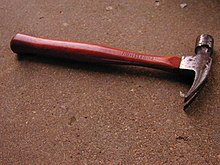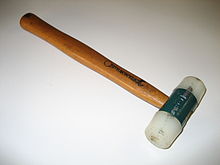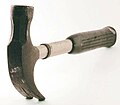Hammer
The hammer is a percussion tool used to directly or indirectly hit a piece, causing its displacement. The most common use of this tool is usually to nail (embed a steel nail in wood or other material), fit parts (by the action of force, and chemistry is used to make this applied in the blow that the piece receives) or break a piece. Hammers are often designed for a special purpose, so their designs vary greatly. One type of hammer, the framing hammer, has an open wedge at the back for driving nails.
The hammer has been around for generations since the 8000s B.C.
History of the hammer
The earliest hammers date back to the Stone Age around 8000 B.C. C. These hammers consisted of a stone attached to a handle with leather straps. Later, in the year 4000 B.C. C., with the discovery of copper, the Romans began to manufacture the heads of the hammers in this material. Later, in the year 3500 a. C., during the Bronze Age they were made with this material. Later, hammers with holes for the handle appeared.
In Norse mythology it is the powerful weapon of the god Thor, whose main power is devastating lightning.
The hammer was a tool that humanity needed to develop its great abilities and to create numerous constructions throughout thousands of years. Along with chisels, it has been a fundamental tool for carving, from stone sculptures made with marble, to putting blocks and dowels in wood to build boats.
It is known that its use is ancestral and has an origin of more than 8000 years, although this is disputed since other researchers believe that it dates back to the Upper Neolithic.
Shape
The basic shape of the hammer consists of a handle (usually wooden) with a heavy head (usually metal) at the end. Hammers are used in different professions and it is one of the basic tools along with the knife.
Known shapes of the hammer are:
- Ball hammer
- Plateholder hammer
- Construction hammer, including the maza
- Heap hammer
- War hammer
- Mechanical hammer
- Geologist hammer
- Nail hammer
- For great efforts there are hammers, which are used in mining and construction. The pneumatic hammer is a portable percutor drill that bases its operation on compressed air mechanisms. It really works like a hammer, because it doesn't scratch, but it hits the surface in order to break it in pieces.
- There are also hydraulic hammers with the same operating principle as tire hammers only here the fluid is hydraulic oil instead of compressed air. These hammers carry them coupled with industrial excavators.
- Also important is the range of non-ferrous hammers that exist, with nylon, plastic, rubber or wood mouths and which are used to give soft blows where the piece that is adjusting cannot deteriorate.
Most used hammers
- Ear hammer: its head has two functions, the flat face to nail, and the other with a groove, to extract them.
- Ball hammer: mechanical use. The ball serves to concentrate the blows on the forging of a concave piece or by deforming the edges of a rivet or robin to perform a riveting bond.
- Wedding hammer: mechanical use. The wedge serves for the hot cut of pieces, similar to the use of the heel for larger pieces, or the cutter for smaller thicknesses.
- Soft mazes: are hammers with skin or plastic or rubber faces that damage less than metallic and are only used for that purpose, damaging and marking the sheet as much as possible.
- Wooden hammer: for ordinary works, from 300 to 350 g; the ebanist hammer (small) is a low weight wedge hammer (100 g).
Physics
As a force amplifier
A hammer is a simple force amplifier that works by converting mechanical work into kinetic energy and vice versa.
In the swing that precedes each blow, the head of the hammer stores a certain amount of kinetic energy - equivalent to the length D of the swing times the force f produced by the muscles of the arm and by gravity. When the hammer strikes, the head is stopped by an opposing force from the target, equal and opposite to the force applied by the head to the target. If the target is a hard, heavy object, or if it is resting on some sort of anvil, the head can only travel a very short distance d before stopping. Since the arresting force F for that distance must be equal to the kinetic energy of the head, it follows that F is much greater than the original driving force f -usually by a factor D'/d. In this way, great force is not needed to produce a force strong enough to bend steel, or break the hardest stone.
Head Mass Effect
The amount of energy delivered to the target by the blow of the hammer is equivalent to half the mass of the head by the square of the speed of the head at the time of impact (E=mv22){displaystyle (E={mv^{2} over 2}}}. While the energy delivered to the target increases linearly with the mass, it increases quadraticly with the speed (see the effect of the handle, below). High-tech titanium heads are lighter and allow longer handles, thus increasing speed and delivering the same energy with less arm fatigue than a heavier steel head hammer. A titanium head has about 3% of regressive energy and can result in greater efficiency and less fatigue when compared to a steel head with up to 30% regress. Dead blow hammers use a special rubber or a steel bullet to absorb the power of the regress, instead of bounce the hammer head after impact.
Handle Effect
The handle of the hammer helps in several ways. Keeps the user's hands away from the point of impact. It provides a wide area that better adapts to the grip of the hand. And more importantly, it allows the user to maximize head speed on every hit. The main limitation of the additional length of the handle is the lack of space to swing the hammer. This is why mallets, which are used primarily in open spaces, can have much longer handles than a standard framing hammer. The second most important limitation is more subtle. Even without accounting for the effects of fatigue, the longer the shaft, the more difficult it is to guide the hammer head towards its target at full speed.
Most designs are a compromise between practicality and energy efficiency. If the handle is too long, the hammer is ineffective as it applies force in the wrong place, off target. With a handle that is too short, the hammer is ineffective because it does not apply enough force, requiring more blows to complete a given task. Changes have also been made to the effect of the hammer on the user. Shock-absorbing handles or variable angles are intended to make it easier for the user to continue handling this age-old artifact, even as nail guns and other power tools encroach on its traditional field of use.
Because hammers must be used in many circumstances, where the position of the person using them cannot be taken for granted, trade-offs are made for the sake of practicality. In areas where a lot of space is available, a long handle with a heavy head (such as a mallet) can bring the maximum amount of energy to the target. However, it is not practical to use such a large hammer for all tasks, so the overall design has been repeatedly modified to achieve optimal utility in a wide variety of situations.
Effect of gravity
Gravity exerts a force on the head of the hammer. If the hammer is hammered down, gravity increases the acceleration during the stroke of the hammer and increases the energy delivered with each blow. If you hammer upwards, gravity reduces the acceleration during the hammer blow and therefore the energy delivered in each blow. Some hammering methods, such as traditional mechanical hammers, rely entirely on gravity for acceleration on the downstroke.
Contenido relacionado
Turbocharger
Botswana Politics
Netscape Navigator









